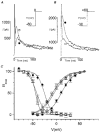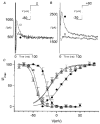Modulation of transient outward current by extracellular protons and Cd2+ in rat and human ventricular myocytes
- PMID: 9714863
- PMCID: PMC2231156
- DOI: 10.1111/j.1469-7793.1998.827bg.x
Modulation of transient outward current by extracellular protons and Cd2+ in rat and human ventricular myocytes
Abstract
1. The effects of extracellular acidosis and Cd2+ on the transient outward current (Ito) have been investigated in rat and human ventricular myocytes, using the whole-cell patch-clamp technique. 2. In rat myocytes, exposure to acidic extracellular solution (pH 6.0) shifted both steady-state activation and inactivation curves to more positive potentials, by 20.5 +/- 2.7 mV (mean +/- S.E.M.; n = 4) and 19.8 +/- 1.2 mV, respectively. Cd2+ also shifted the activation and inactivation curves in a positive direction in a concentration-dependent manner. 3. In human myocytes, the steady-state activation and inactivation curves were located at more positive potentials. The effect of Cd2+ was similar, but acidosis had less effect than in rat myocytes (e.g. pH 6.0 shifted activation by only 7.2 +/- 2.2 mV and inactivation by 13.7 +/- 0.5 mV; n = 4). 4. In both species, the effect of acidosis decreased with increasing concentrations of Cd2+ and vice versa, suggesting competition between H+ and Cd2+ for a common binding site. 5. The data indicate that acidosis and divalent cations influence Ito via a similar mechanism and act competitively in both rat and human myocytes, but that human cells are less sensitive to the effects of acidosis.
Figures









Similar articles
-
Divalent cations modulate the transient outward current in rat ventricular myocytes.Am J Physiol. 1991 Aug;261(2 Pt 1):C310-8. doi: 10.1152/ajpcell.1991.261.2.C310. Am J Physiol. 1991. PMID: 1872373
-
Effects of chloride ion substitutes and chloride channel blockers on the transient outward current in rat ventricular myocytes.Biochim Biophys Acta. 1996 Jan 11;1273(1):31-43. doi: 10.1016/0005-2728(95)00127-1. Biochim Biophys Acta. 1996. PMID: 8573593
-
Effect of Cd2+ on Kv4.2 and Kv1.4 expressed in Xenopus oocytes and on the transient outward currents in rat and rabbit ventricular myocytes.Cell Physiol Biochem. 1999;9(1):11-28. doi: 10.1159/000016299. Cell Physiol Biochem. 1999. PMID: 10352341
-
Extracellular divalent cations block a cation non-selective conductance unrelated to calcium channels in rat cardiac muscle.J Physiol. 1997 Jul 15;502 ( Pt 2)(Pt 2):235-47. doi: 10.1111/j.1469-7793.1997.235bk.x. J Physiol. 1997. PMID: 9263906 Free PMC article.
-
[Effects of isovitexin on transient outward potassium current of ventricular myocytes in rats].Zhongguo Zhong Yao Za Zhi. 2017 Dec;42(24):4864-4869. doi: 10.19540/j.cnki.cjcmm.20170919.002. Zhongguo Zhong Yao Za Zhi. 2017. PMID: 29493159 Chinese.
Cited by
-
A novel transgenic reporter of extracellular acidification in zebrafish elucidates skeletal muscle T-tubule pH regulation.Dev Dyn. 2025 Jan 22:10.1002/dvdy.770. doi: 10.1002/dvdy.770. Online ahead of print. Dev Dyn. 2025. PMID: 39840753
-
Effects of halothane on the transient outward K(+) current in rat ventricular myocytes.Br J Pharmacol. 2000 Sep;131(2):223-30. doi: 10.1038/sj.bjp.0703565. Br J Pharmacol. 2000. PMID: 10991914 Free PMC article.
-
A mathematical model of action potential heterogeneity in adult rat left ventricular myocytes.Biophys J. 2001 Dec;81(6):3029-51. doi: 10.1016/S0006-3495(01)75943-7. Biophys J. 2001. PMID: 11720973 Free PMC article.
-
Inhibition of the K+ channel kv1.4 by acidosis: protonation of an extracellular histidine slows the recovery from N-type inactivation.J Physiol. 2000 Jul 15;526 Pt 2(Pt 2):253-64. doi: 10.1111/j.1469-7793.2000.00253.x. J Physiol. 2000. PMID: 10896716 Free PMC article.
-
From ionic to cellular variability in human atrial myocytes: an integrative computational and experimental study.Am J Physiol Heart Circ Physiol. 2018 May 1;314(5):H895-H916. doi: 10.1152/ajpheart.00477.2017. Epub 2017 Dec 22. Am J Physiol Heart Circ Physiol. 2018. PMID: 29351467 Free PMC article.
References
-
- Agus ZS, Dukes ID, Morad M. Divalent cations modulate the transient outward current in rat ventricular myocytes. American Journal of Physiology. 1991;261:C310–318. - PubMed
-
- Antzelevitch C, Sicouri S, Litovsky SH, Lukas A, Krishnan SC, Di Diego JM, Gintant GA, Liu D. Heterogeneity within the ventricular wall. Electrophysiology and pharmacology of epicardial, endocardial, and M cells. Circulation Research. 1991;69:1427–1449. - PubMed
-
- Apkon M, Nerbonne JM. Characterization of two distinct depolarization-activated K+ currents in isolated adult rat ventricular myocytes. Journal of General Physiology. 1991;97:973–1011. 10.1085/jgp.97.5.973. - DOI - PMC - PubMed
-
- Coraboeuf E, Carmeliet E. Existence of two transient outward currents in sheep cardiac Purkinje fibers. Pflügers Archiv. 1982;392:352–359. - PubMed
Publication types
MeSH terms
Substances
LinkOut - more resources
Full Text Sources

